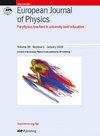用深度学习解决微分方程:初学者指南
IF 0.8
4区 教育学
Q4 EDUCATION, SCIENTIFIC DISCIPLINES
引用次数: 0
摘要
近年来,研究具有潜在科学应用价值的人工智能方法已成为科学界的一项重要任务。物理信息神经网络(PINNs)就是其中的一种方法,它代表了一种基于神经网络基础来求解微分方程的当代技术。这些网络可以潜在地改进或补充计算物理中的经典数值方法,使其成为一个令人兴奋的研究领域。在本文中,我们在初级阶段介绍了pin,主要面向物理教育,使其适用于本科和研究生阶段的教育目的。pin可用于创建虚拟模拟和教育工具,以帮助理解涉及微分方程的复杂物理概念和过程。通过将神经网络的力量与物理原理相结合,pinn可以提供互动和引人入胜的学习体验,从而提高学生对高等教育中物理概念的理解和保留。本文章由计算机程序翻译,如有差异,请以英文原文为准。
Solving differential equations with Deep Learning: a beginner's guide
Abstract The research in Artificial Intelligence methods with potential applications in science has become an essential task in the scientific community in recent years. Physics Informed Neural Networks (PINNs) is one of these methods and represents a contemporary technique based on neural network fundamentals to solve differential equations. These networks can potentially improve or complement classical numerical methods in computational physics, making them an exciting area of study. In this paper, we introduce PINNs at an elementary level, mainly oriented to physics education, making them suitable for educational purposes at both undergraduate and graduate levels. PINNs can be used to create virtual simulations and educational tools that aid in understating complex physical concepts and processes involving differential equations. By combining the power of neural networks with physics principles, PINNs can provide an interactive and engaging learning experience that can improve students' understanding and retention of physics concepts in higher education.
求助全文
通过发布文献求助,成功后即可免费获取论文全文。
去求助
来源期刊

European Journal of Physics
物理-物理:综合
CiteScore
1.70
自引率
28.60%
发文量
128
审稿时长
3-8 weeks
期刊介绍:
European Journal of Physics is a journal of the European Physical Society and its primary mission is to assist in maintaining and improving the standard of taught physics in universities and other institutes of higher education.
Authors submitting articles must indicate the usefulness of their material to physics education and make clear the level of readership (undergraduate or graduate) for which the article is intended. Submissions that omit this information or which, in the publisher''s opinion, do not contribute to the above mission will not be considered for publication.
To this end, we welcome articles that provide original insights and aim to enhance learning in one or more areas of physics. They should normally include at least one of the following:
Explanations of how contemporary research can inform the understanding of physics at university level: for example, a survey of a research field at a level accessible to students, explaining how it illustrates some general principles.
Original insights into the derivation of results. These should be of some general interest, consisting of more than corrections to textbooks.
Descriptions of novel laboratory exercises illustrating new techniques of general interest. Those based on relatively inexpensive equipment are especially welcome.
Articles of a scholarly or reflective nature that are aimed to be of interest to, and at a level appropriate for, physics students or recent graduates.
Descriptions of successful and original student projects, experimental, theoretical or computational.
Discussions of the history, philosophy and epistemology of physics, at a level accessible to physics students and teachers.
Reports of new developments in physics curricula and the techniques for teaching physics.
Physics Education Research reports: articles that provide original experimental and/or theoretical research contributions that directly relate to the teaching and learning of university-level physics.
 求助内容:
求助内容: 应助结果提醒方式:
应助结果提醒方式:


